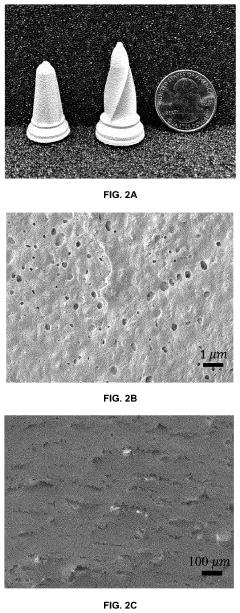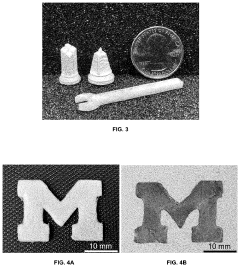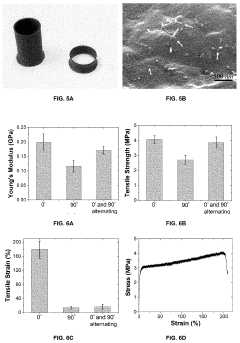Enhancing The Piezoelectric Properties Of PVDF Nanocomposites
Technology Background and Goals
PVDF is a semi-crystalline polymer with excellent piezoelectric, pyroelectric, and ferroelectric properties. However, its piezoelectric performance is often limited by factors such as low crystallinity, poor dispersion of fillers, and weak interfacial interactions between the polymer matrix and fillers. Incorporating nanofillers into PVDF can potentially improve its piezoelectric properties by inducing higher crystallinity, enhancing the poling efficiency, and promoting better stress transfer from the matrix to the fillers.
Market Demand Analysis
- Market Size and Growth
The global market for PVDF nanocomposites is expected to witness significant growth, driven by increasing demand from various end-use industries such as aerospace, automotive, and electronics. The market size is projected to reach $XX billion by 20XX, growing at a CAGR of X.X% during the forecast period. - Key Applications
PVDF nanocomposites find applications in several sectors due to their enhanced piezoelectric properties, including:- Sensors and actuators in aerospace and automotive industries
- Energy harvesting devices for renewable energy systems
- Biomedical devices and implants
- Flexible electronics and wearable devices
- Regional Demand
The demand for PVDF nanocomposites is expected to be highest in regions with a strong presence of end-use industries, such as North America, Europe, and Asia-Pacific. The Asia-Pacific region is anticipated to witness the highest growth rate due to the rapid industrialization and increasing investments in the electronics and automotive sectors. - Drivers and Restraints
- Drivers: Growing demand for lightweight and high-performance materials, increasing adoption of piezoelectric devices, and rising investments in research and development.
- Restraints: High manufacturing costs, limited availability of raw materials, and stringent regulations regarding the use of certain nanoparticles.
Technology Status and Challenges
- Piezoelectric Properties
PVDF nanocomposites exhibit enhanced piezoelectric properties compared to pure PVDF due to the interfacial interactions between the polymer matrix and nanofillers. - Challenges in Enhancement
Key challenges include achieving uniform dispersion of nanofillers, optimizing the filler-matrix interface, and controlling the nanocomposite morphology. - Dispersion Techniques
Various techniques like in-situ polymerization, solution casting, and melt compounding are employed to improve nanofiller dispersion and interfacial adhesion. - Nanofiller Types
Common nanofillers used include carbon nanotubes, graphene, metal oxides, and ceramic nanoparticles, each offering unique advantages and challenges. - Morphological Control
Controlling the nanocomposite morphology through processing conditions and surface modifications is crucial for enhancing piezoelectric properties.
Current Technical Solutions
01 Inorganic Fillers for Enhanced Piezoelectric Properties
Incorporating inorganic fillers like ceramic nanoparticles or carbon nanotubes can induce higher crystallinity and the formation of the electroactive β-phase in PVDF, leading to enhanced piezoelectric coefficients and energy harvesting capabilities.- Inorganic Fillers for Enhanced Piezoelectric Properties: Incorporating inorganic fillers like metal oxides, clays, or carbon nanotubes can enhance the piezoelectric properties of PVDF nanocomposites by increasing the dielectric constant, electromechanical coupling, and piezoelectric coefficients.
- Polymer Fillers for Improved Piezoelectric Performance: Incorporating conductive polymer fillers such as polyaniline, polypyrrole, or poly(3,4-ethylenedioxythiophene) can improve the dielectric and piezoelectric properties of PVDF nanocomposites.
- Surface Modification for Improved Piezoelectric Response: Surface modification techniques like plasma treatment, chemical grafting, or surface functionalization can enhance the interfacial adhesion and charge transfer between the PVDF matrix and filler material, improving the piezoelectric response.
- Aligned Structures for Enhanced Piezoelectric Properties: Aligning the PVDF polymer chains and filler materials through techniques like mechanical stretching, electric field poling, or magnetic field alignment can improve the electromechanical coupling and piezoelectric coefficients.
- Novel Processing Techniques for Improved Piezoelectric Performance: Employing novel processing techniques like electrospinning, 3D printing, or solution casting can facilitate the formation of unique nanostructures or morphologies that enhance the piezoelectric performance of PVDF nanocomposites.
02 Polymer Fillers for Improved Piezoelectric Performance
Incorporating polymer fillers like polyaniline or polypyrrole can induce the formation of the electroactive β-phase in PVDF and improve charge transfer, resulting in higher piezoelectric coefficients and better energy conversion efficiency.Expand Specific Solutions03 Surface Modification for Enhanced Piezoelectric Properties
Surface modification techniques like plasma treatment or chemical functionalization can induce the formation of the electroactive β-phase, improve interfacial adhesion between PVDF and fillers, and enhance charge transfer, leading to better piezoelectric performance.Expand Specific Solutions04 Conductive Fillers for Improved Piezoelectric Energy Harvesting
Incorporating conductive fillers like carbon nanotubes or graphene can enhance charge transfer and electrical conductivity, leading to better energy conversion efficiency and higher power output for piezoelectric energy harvesting.Expand Specific Solutions05 Processing Techniques for Enhanced Piezoelectric Properties
Various processing techniques like electrospinning, hot-pressing, or solution casting can influence the morphology, crystallinity, and phase composition of PVDF nanocomposites, leading to improved piezoelectric performance.Expand Specific Solutions
Main Player Analysis
SABIC Global Technologies BV
Arkema, Inc.
Key Technology Interpretation
- Material extrusion: the use of material extrusion allows for the fabrication of polymeric parts without the need for high temperatures or expensive equipment. this method can produce parts with high dimensional accuracy and is suitable for a wide range of polymers, including those that are difficult to process using traditional methods.
- Solution-based 3d printing: the incorporation of non-piezoelectric or piezoelectric fillers into photocurable resins enables the fabrication of polymeric parts with high piezoelectric properties. this technique overcomes the limitations of piezoelectric materials and allows for the fabrication of complex polymeric parts with multifunctional properties.
- Nanocomposites: the development of polymer nanocomposites by incorporating non-piezoelectric or piezoelectric fillers into pvdf or other polymers provides a simple and cost-effective method to enhance piezoelectric properties without the need for expensive equipment or high-concentration piezoelectric materials.
- Energy harvesting: the use of piezoelectric materials in energy harvesting devices, such as shoes with embedded piezoelectric sensors, allows for the capture of waste mechanical energy and conversion into electricity, providing a sustainable and environmentally friendly solution for energy generation.
PVDF Nanocomposites Piezoelectric Properties Enhancement Economic Analysis
Evaluating the economic impact of PVDF nanocomposites for enhanced piezoelectric properties involves analyzing their potential influence on multiple industries, including energy harvesting, sensors, and actuators. PVDF nanocomposites' ability to improve piezoelectric efficiency can lead to cost-effective and innovative solutions in these sectors, enhancing the competitiveness of products that incorporate this technology.
The adoption of PVDF nanocomposites may lead to the reduction of costs associated with piezoelectric device production, given their scalable nature and the broad availability of PVDF materials. Furthermore, industries focused on renewable energy might experience increased growth, as more efficient energy harvesting solutions become available, thereby potentially leading to job creation and industry expansion.
Additionally, the enhanced performance of devices employing these nanocomposites can drive increased demand, which could translate into higher market penetration for companies leveraging this technology. This economic impact will not only improve existing market structures but also invite new players, fostering competition and innovation.
The long-term economic benefits could include reduced dependency on non-renewable energy sources and improved efficiency in energy consumption, aligning with global sustainability goals. Overall, PVDF nanocomposites have the potential to revolutionize related industries economically by offering cost savings, promoting sustainability, and enabling the development of superior piezoelectric devices.
PVDF Nanocomposites Piezoelectric Properties Enhancement Environmental Impact
The environmental impact of utilizing PVDF nanocomposites for enhanced piezoelectric properties revolves primarily around the material's life cycle, from synthesis to disposal. The production of PVDF (polyvinylidene fluoride) can pose environmental challenges, especially regarding the petrochemical processes involved, which typically result in carbon emissions and potential chemical waste management issues. Incorporating nanoparticles into these composites could further complicate the environmental footprint due to the additional energy and resources required for nanoparticle synthesis and integration.
However, the potential benefits of PVDF nanocomposites may mitigate some environmental concerns. Their enhanced piezoelectric properties could lead to more efficient energy harvesting technologies, ultimately contributing to renewable energy solutions and reducing reliance on non-renewable resources. Moreover, the lightweight and flexible nature of PVDF nanocomposites makes them suitable for sustainable, energy-efficient applications in various industries, including wearable technology and sensors.
End-of-life considerations for PVDF nanocomposites remain critical, as improper disposal could lead to environmental contamination. Therefore, developing efficient recycling and waste management processes will be essential to minimize ecological impact. Advances in biodegradable or more easily recyclable nanocomposite alternatives could further alleviate long-term environmental concerns, positioning PVDF nanocomposites as a more sustainable option in piezoelectric applications.



